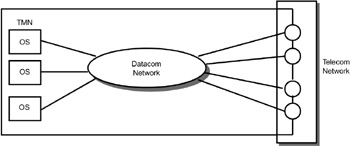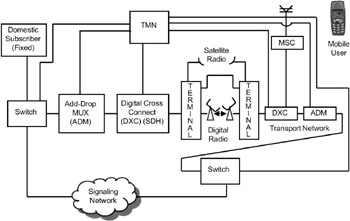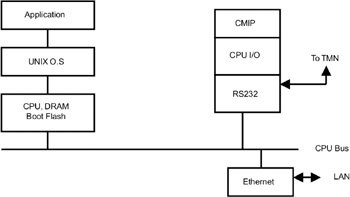37.1 OVERVIEW OF TMN
|
| < Day Day Up > |
|
37.1 OVERVIEW OF TMN
Telecommunication network management is very important to provide reliable and efficient service to customers. The telecom service provider needs to have the necessary information on the functioning of various network elements such as subscriber terminals, switches, routers, multiplexers, radio base stations, digital cross connect equipment, and so on. Presently, the functioning of these network elements is generally known only locally, where the network element is installed. Ideally, all network elements should be monitored from a central location.
Telecommunications network management involves ensuring reliable functioning of various network elements, collecting traffic information, and optimal utilization of network resources.
Furthermore, network management involves obtaining statistical information about the traffic. If the traffic is heavy on a particular route, the operator has to increase the bandwidth for that route to get more revenue. Also, billing information has to be collected at a central location for easy administration—generation and distribution of bills. All this calls for efficient centralized network management. TMN provides the solution.
| Note | The objective of a telecommunications management network is to achieve multivendor multiplatform network management using standard protocols. |
As shown in Figure 37.1, TMN achieves interoperability by defining a data communication network that interacts with the various network elements for obtaining management information and presenting it in a user-friendly manner.

Figure 37.1: A telecommunications management network.
The operations systems (OSs) carry out network management operations such as monitoring and controlling the telecom network elements. However, the challenge lies in developing a framework that will ensure that legacy systems can also be brought into the TMN. Network elements (NEs), such as switching systems, multiplexers, and radio equipment, are managed through standard interfaces defined in TMN. If the NE is TMN compliant, it is fine; otherwise it communicates through a Q-adapter (QA). Defining the standard interfaces is the important feature of TMN, As shown in Figure 37.2, public networks such as PSTN and PLMN, consisting of various types of equipment such as satellite systems, digital terrestrial radio systems, optical fiber systems, multiplexers, and all types of switching and transmission systems can be controlled through TMN. The power of TMN is evident from this figure: every network element based on cable, radio, or fiber technology can be brought under the purview of TMN. In this figure, the switch, add-drop multiplexer (ADM), digital cross connect (DXC), digital radio terminal, satellite radio terminal, and mobile switching center of a mobile communication system are the network elements managed by the TMN.

Figure 37.2: Public networks with TMN.
A telecommunications management network (TMN) is a data communication network exclusively for managing telecommunications networks. Standard interfaces and protocols have been developed to manage the network elements.
| Note | Communication equipment such as switches, multiplexers, repeaters, and radio equipment are called network elements. All these network elements can be controlled by TMN. |
In line with the developments in programming languages, TMN uses object-oriented technology—each managed resource is viewed as an object. TMN defines guidelines for definition of managed objects (GDMO), which provide templates for classifying and describing the managed objects. The network-managed information and the rules by which the information is managed and presented are referred to as the management information base (MIB). This feature of TMN enables real-life modeling of telecom systems, so TMN implementation is pretty easy. The MIB framework is similar to the MIB discussed in SNMP.
TMN uses object-oriented technology. Each managed resource is viewed as an object. Hence, TMN allows real-life modeling of telecom systems.
| Note | In TMN, network management information is exchanged using the management information base (MIB). The MIB framework is similar to that of Simple Network Management Protocol (SNMP). |
To enable the various entities in TMN to communicate with each other, a protocol architecture is defined that is based on OSI management architecture. A TMN manager connects to the TMN and manages the network elements through a user interface provided to the operator. The TMN manager architecture is shown in Figure 37.3. One of the standard protocols defined in TMN is common management information protocol (CMIP), which defines the management services exchanged between peer entities. All telecommunications equipment manufacturers are implementing the TMN for efficient network management.

Figure 37.3: TMN manager architecture.
Common Management information protocol (CMIP) is used in TMN to define the management services exchanged by different objects.
|
| < Day Day Up > |
|
EAN: 2147483647
Pages: 313
- Structures, Processes and Relational Mechanisms for IT Governance
- Linking the IT Balanced Scorecard to the Business Objectives at a Major Canadian Financial Group
- Measuring ROI in E-Commerce Applications: Analysis to Action
- Governing Information Technology Through COBIT
- Governance Structures for IT in the Health Care Industry